and the distribution of digital products.
DM Television
12 social media competitor analysis tools to get ahead in 2025
Social media competitor analysis tools should be a staple in every social manager’s toolbox.
Why? Because, a social media competitor analysis tool is a type of software that allows you to benchmark your social performance against that of your competitors. And while it’s easy to get caught up in analyzing your own social media efforts, context matters — your performance is much more valuable when compared to the strategies of your competitors.
Once you implement the right competitor research tools, you can learn something from every post — and make informed changes to refine your strategy to stay ahead of the competition.
More of a visual learner? Learn how to conduct a social media competitor analysis in just three simple steps.
Free social media competitive analysis templateWanna dive right into competitive analysis?
Download our (totally free!) customizable template and start mapping out opportunities for your next win on social.
Bonus!!!Get a free, customizable competitive analysis template to easily size up the competition and identify opportunities for your brand to pull ahead.
Download nowKeep reading to get into the best competitor analysis tools for social media.
12 of the best social media competitor analysis tools for 2025 1. HootsuiteHootsuite offers built-in competitor analysis and benchmarking tools within Hootsuite Analytics.
Competitor analysis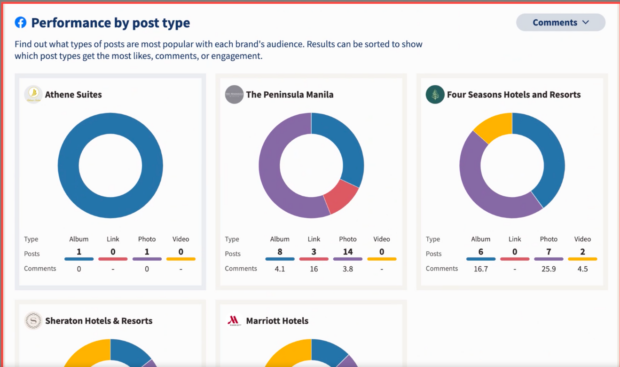
All you have to do is build your competitor watchlist by adding up to 20 hand-picked competitive accounts. (The number you can add varies depending on your Hootsuite plan.)
Then, with just a couple of clicks, you can generate a competitive benchmarking report that includes the following social media metrics for every competitor:
- Number of posts published
- Posting frequency
- Average engagement rate
- Number of fans or followers
- Audience growth rate
- Estimated total engagement
You can also see more detailed analysis results, such as:
- Content performance: Take a look at the top and lowest-performing posts based on your chosen metric.
- Performance by types of content: How different formats of posts performed based on your chosen metric.
- Trending hashtags: A word cloud of the most-used hashtags from your competitors’ top posts based on your chosen metric.
- Post length: Average character count and number of hashtags in your competitors’ posts.
Competitor analysis is available for X (formerly Twitter), Facebook, and Instagram.
Industry benchmarking
Hootsuite’s user-friendly industry benchmarking tool is especially useful if you’re not sure yet who your competitors are. Just choose your industry, and this social media management tool does the rest.
You can compare your results for several metrics to the industry average and see charts tracking the pattern over time. The competitor data benchmarking tool also provides recommendations to improve your social media marketing strategy and results.
Industry benchmarking is available for Facebook, Instagram, X, LinkedIn, and TikTok.
Social listeningSet up a social listening strategy to keep a keen eye on your top competitors’ social media activity. Hootsuite Listening‘s industry-leading AI-powered social listening tool allows you to gather your competitors’ content in one dashboard in real time.

Plus, you can use Quick Search to analyze things like:
- Results. Check out a selection of popular posts related to your search terms — you can filter by sentiment, channel, and more.
- Key metrics. Are more people talking about you this week? What’s the vibe of their posts? Hootsuite Listening doesn’t just track what people are saying — it uses enhanced sentiment analysis to tell you how they really feel.
- Top themes. How are people talking about you? What are the most popular positive and negative posts about? Which other conversations are you showing up in?
Learn more about how to set up a social media analytics strategy.
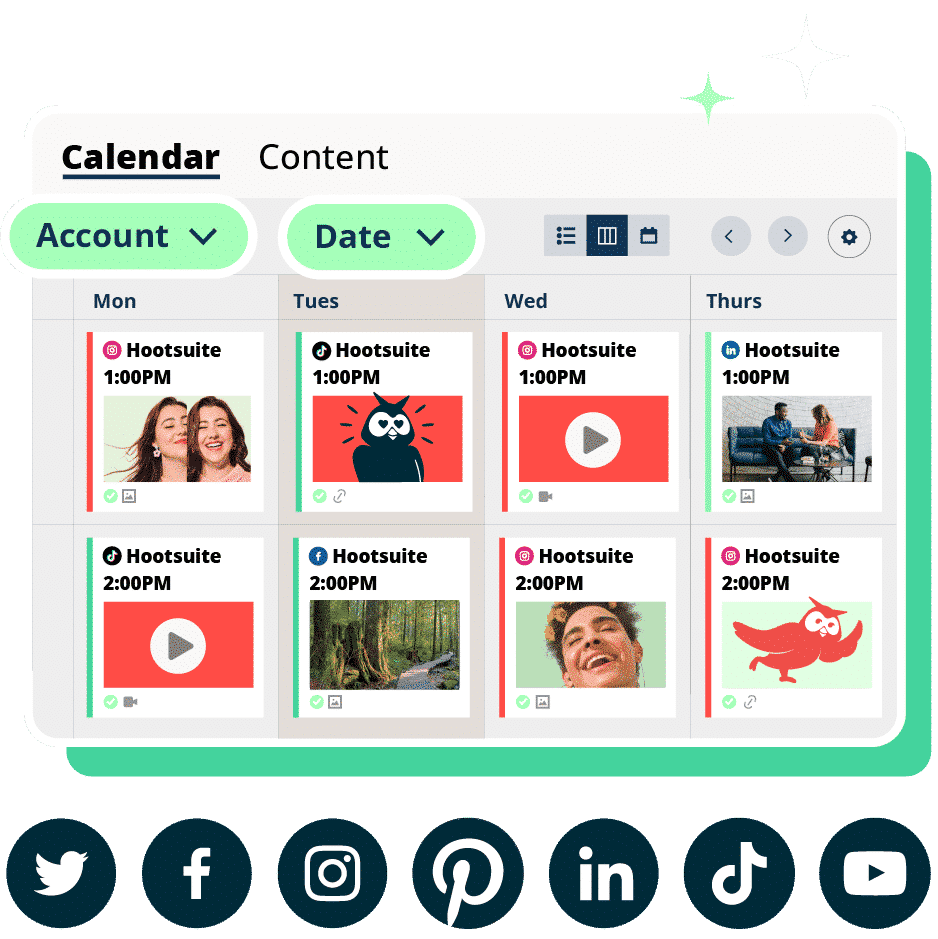 #1 Social media tool
#1 Social media tool
Create. Schedule. Publish. Engage. Measure. Win.
Free 30-day trial 2. Phlanx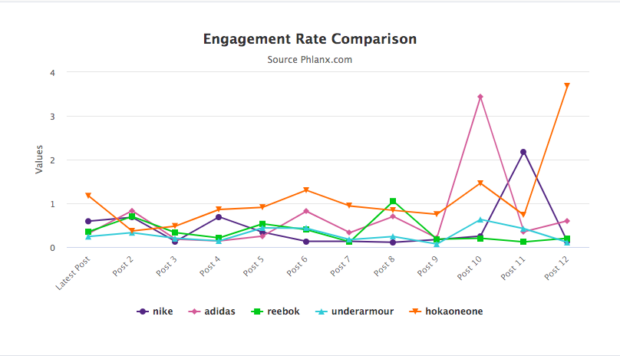
Source: Phlanx
Phlanx offers competition trackers for Instagram, YouTube, X, and Twitch.
The competitor analysis dashboard is clear and easy to understand, and Phlanx offers a beginner-friendly price point.
However, the competitive benchmarking is based on engagement rate only, so keep this in mind if you want to analyze additional social media metrics.
3. Sprinklr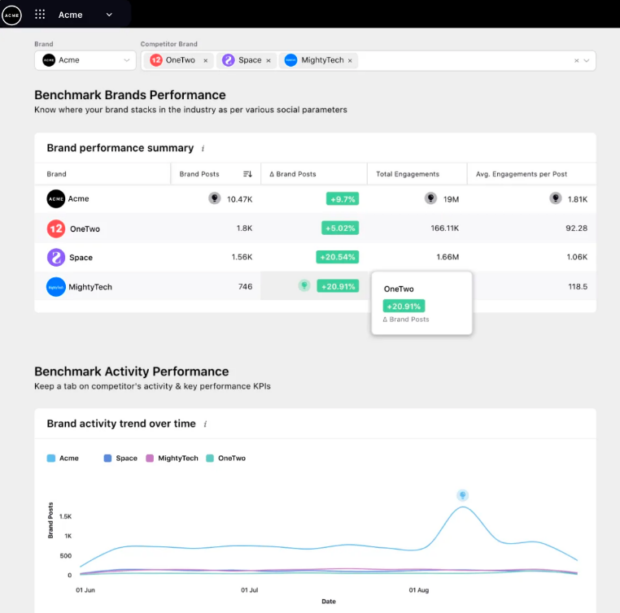
Source: Sprinklr
Sprinklr provides competitive analysis insights for Facebook, X, Instagram, and YouTube, as well as Quora, VK, and Sina Weibo. It does not include LinkedIn or TikTok.
The reports analyze your competitors’ content types, post themes, post categories, sentiment, and tone.
Sprinklr does allow you to monitor your competitors’ social media content, but it’s not cheap. This enterprise-level solution starts at nearly $3,600 per user per year. See how Sprinklr compares with Hootsuite.
4. Social Blade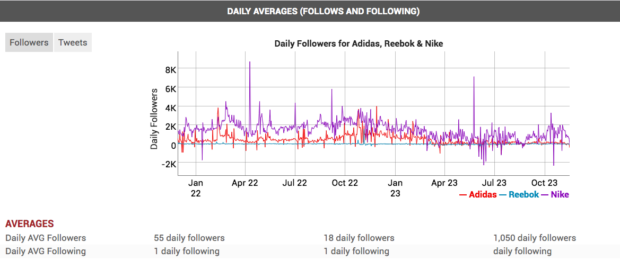
Source: Social Blade
Social Blade’s tool for social media competitor performance analysis allows you to compare three accounts per chart for X, YouTube, and Twitch using their free online tool.
The stats tracked vary by network. For X, the comparison focuses on followers, follower growth, and number of posts.
An interesting feature is the ability to look up a competitor’s handle on various social platforms (including Instagram and Facebook) to see the “grade” assigned to them based on their Social Blade Rank. It’s based on metrics like number of followers and engagement rate.
5. Later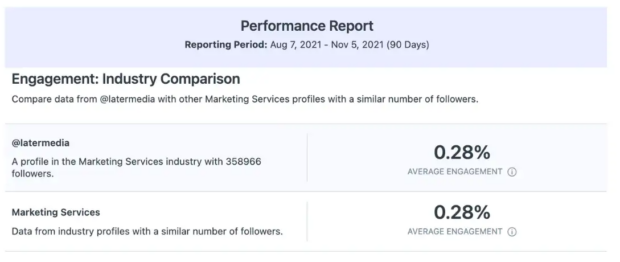
Source: Later
Later provides Instagram engagement rate benchmarking against the industry average for accounts with a similar following. It also offers a weekly report of the top 50 industry hashtags on Instagram.
If you’re only focused on Instagram and only need an overview of how your engagement rate stacks up against the industry average, this could be a good competitive tool for you.
However, it may not be one of the best social media competitor analysis tools to choose if you need to perform an in-depth analysis or monitor competitors’ strategies across multiple social media platforms.
Find out more about how Later compares to Hootsuite.
6. Sprout Social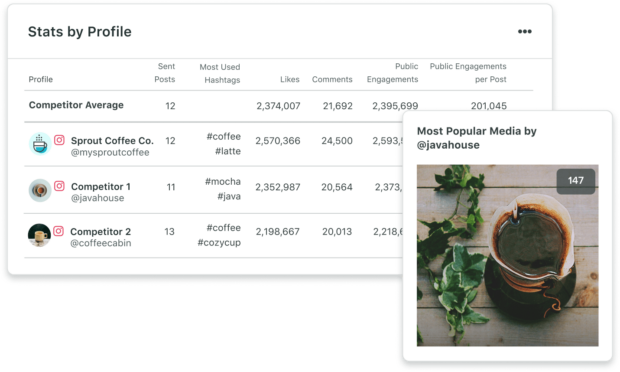
Source: Sprout Social
Sprout Social offers a social media competitor analysis tool to compare your key metrics against top competitors. You can also benchmark your performance against others in your industry. There are social listening tools to help identify keywords and hashtags.
There are solid competitive analytics features here, but they lack some of the customization options savvy social marketers may look for. It’s also a pricey solution, with an average cost of $332 per user seat.
See how Sprout Social compares to Hootsuite.
7. BuzzSumo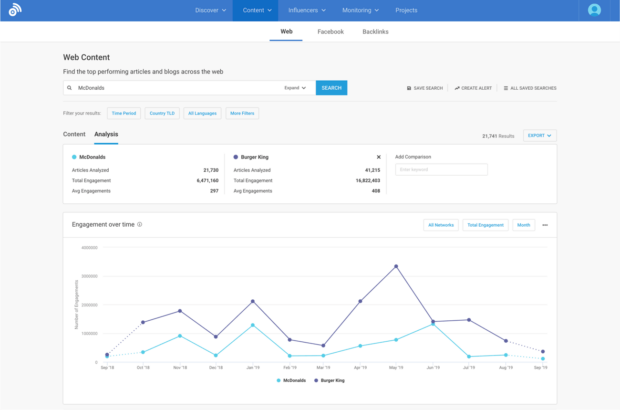
Source: BuzzSumo
BuzzSumo is a content marketing tool designed to provide data to guide digital marketing decisions. Part of that data discovery involves competitor analysis.
BuzzSumo tracks key competitor metrics across the web. For social channels, they focus on Facebook, where you can analyze engagement based on post type, post length, and time published.
You can also find the top shared content across social networks based on a keyword search, and get a breakdown of the most popular social platforms in your niche.
Overall, this monitoring tool provides the most competitive insight if your social media marketing strategy is primarily focused on Facebook.
8. Keyhole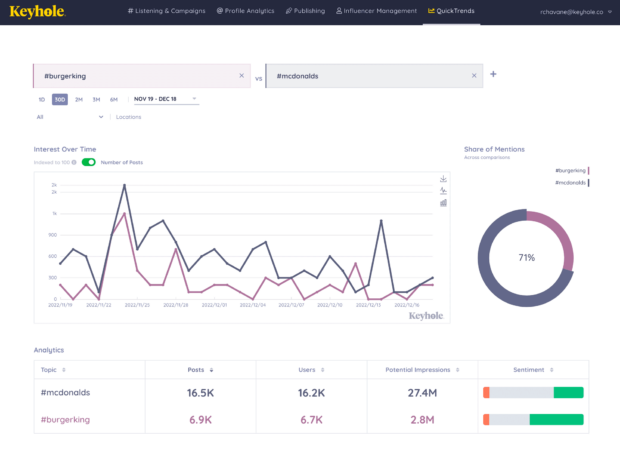
Source: Keyhole.co
Keyhole is a social media competitive analysis tool that allows you to do some free competitor keyword and hashtag research. You can use the search bar at Keyhole.co to determine which social platforms a hashtag was used on and the top referring sites and accounts. This is particularly useful for branded or campaign hashtags.
If you sign up for a paid plan, you can access more detailed competitive analytics and competitor benchmarking.
9. Mentionlytics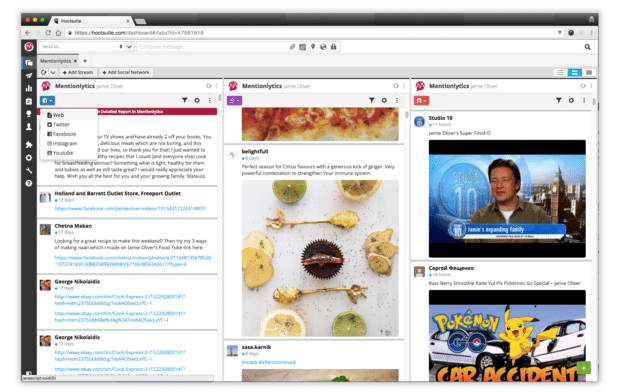
Source: Mentionlytics
Mentionlytics is a social media monitoring tool for conducting a social media competitive analysis. You can discover everything being said about your brand, your competitors, or any keyword on X, Instagram, Facebook, Youtube, Pinterest, and web sources (news, blogs, etc.).
Plus, it has a handy “sentiment analysis” feature, so you can see not only what is being said about your competitors but how it is being said.
PS: Mentionlytics integrates with Hootsuite so you can see everything it pulls in your Streams.
10. Brandwatch
Source: Brandwatch
Brandwatch offers some powerful competitive analysis tools. One of the most important is its easy-to-understand graphic showing your brand’s social share of voice.
Social share of voice is a measure of how much people talk about your brand online compared to how much they talk about your competitors. This is one of the metrics you should track in your social media competitive analysis template.
11. SEMrush
Source: SEMrush
SEMrush is more widely known for its SEO and digital marketing capabilities, but it also packs a serious punch when it comes to social media competitor analysis.
The platform lets you track and compare your competitors’ social media performance across Facebook, Instagram, Twitter, and LinkedIn.
What makes SEMrush stand out is its deep data analysis and reporting features. The downside? Due to its expansive range of features, it can be a bit overwhelming for beginners.
12. Similarweb
Source: Similarweb
Similarweb is often the go-to tool for traffic analysis, but its social media capabilities should not be overlooked.
With Similarweb, you can track social media traffic trends for competitors across platforms like Facebook, Instagram, YouTube, and more.
It offers an overview of how your competitors are performing online, from social traffic sources to engagement metrics. It’s helpful if you’re aiming to understand the full customer journey and how social media fits into it.
7 tips for using competitor intelligence in your social strategy 1. Set realistic goalsUnderstanding how well your competitors’ social posts perform makes it much easier to set realistic performance goals for your own content.
This is especially helpful when you’re starting a new account or adding a new social platform to your social strategy, since you don’t have a lot of your own data to work from yet.
But even when you have an established social presence, understanding what your competitors are up to (and what kinds of results they’re getting) helps keep your expectations realistic in a constantly changing field.
A good social media competitive analysis tool will give you an easy overview of your competitors’ top-performing posts based on the metrics that matter most to you.
In combination with analysis reports and benchmarking tools that compare overall account performance, this gives you a clear sense of the possibilities within your niche.
2. Analyze your results vs. your competitors’Just as a competitive analysis helps you know what to expect and how to plan, it also helps you understand your results after the fact. This is particularly useful if you see an unexpected result or an overall change in the trends of your social performance.
Rather than trying to understand your results in isolation, you can check whether your competitors are seeing similar changes. This can help you analyze the reasons for the change: Is it a response to your specific content or a shifting trend industry-wide?
With this better understanding of what your results mean in context, you can better plan how to respond. Do you need to experiment to adjust to a change in the algorithm? Shift your post type or content mix? Knowing what’s happening with your competitors gives you a much greater pool of data to draw from.
3. Discover new ideas and inspirationSocial media competitive intelligence tools bring the top-performing content from your main competitors into one place, so you can see at a glance what’s working best within your industry.
This is a far more effective way to understand the social landscape than checking all their various accounts. (Bonus: You don’t have to give them a follow!)
Keeping an eye on top-performing competitor content, in particular, is a good way to stay on top of relevant memes, trends, hashtags, and strategies that have been proven to connect with an audience similar to your own.
You never want to copy your competitors’ content, of course, but you absolutely do want to learn from and experiment with the strategies that worked for them. Especially when it comes to influencer marketing, you can get some valuable insights into how influencers are performing and driving engagement with their audience.
4. Get clear on what makes you differentUnderstanding how your competitors position themselves also helps you understand how best to differentiate your brand.
What makes you different? Where do you excel? What unique benefits do you offer that make you truly stand out from the competition?
All of this boils down into your unique selling proposition (USP). Your USP is a critical part of your social media strategy. In fact, it’s the foundation of your entire brand identity. Analyzing your brand in the full context of the competitive marketplace makes sure your USP is accurate and compelling.
Ongoing competitive analysis also provides an early warning system in case a new or existing competitor tries to hone in on your USP.
The idea is never to disparage your competitors but to make sure your audience understands the unique benefits you provide.
5. Find out what your audience wantsYou can gain some powerful audience insights from competitor analysis tools. First, you’ll get a good sense of the potential audience size for a brand in your particular niche.
But diving deeper, you can also see what works best for connecting with your audience. Competitive analysis tools can help you answer questions like:
- What are the social platforms where your audience is most interested in engaging with brands like yours?
- Do they prefer videos or text posts? Stories or Reels?
- What tone of content seems to resonate? Should you make some tweaks to your brand voice?
- When are they most likely to engage with social content?
- What problems are they experiencing with your competitors? Are there pain points you can help resolve through existing services or new innovations?
- What do they love most about your competitors? Are there elements of your products and services you need to work on or highlight?
Understanding how your audience engages with competitor content provides a good starting point for your own content strategy. It’s also essential to take into account the demographics of your audience, which can vary significantly from one competitor to the next.
Hashtag analysis is useful here too. Rather than just leaping on a new hashtag you spot in your competitive analysis, put some thought into the intent behind the hashtag. What can it tell you about your audience, and the ways they think about their social personas? Does it offer clues on how you can better position your brand?
6. Expand your reach with new hashtags and keywordsWe’ve mentioned hashtags a couple of times already in terms of customer intent and trending topics. But it’s also important to review your competitors’ social strategies to discover the terms that are helping them grow their audiences beyond existing followers.
Hashtags are the easiest to identify, of course. But take a deeper look at your competitors’ content with the widest reach. Are there specific keywords and phrases that could be getting their content in front of new eyeballs?
Competitive analysis can be a key input for your social media marketing and social SEO strategy. You can also use market research and market trends to spot emerging keywords that will help you reach your audience more effectively.
7. Perform a SWOT analysisA SWOT analysis is a specific type of brand analysis that long pre-dates social media. It’s a highly effective way of understanding the competitive landscape right now as well as what’s on the horizon.
SWOT stands for strengths, weaknesses, opportunities, and threats. Strengths and weaknesses are internal, while opportunities and threats are external.
- Strengths. These are the things you’re already doing right. You’re meeting or exceeding your goals, and you’re at least on pace with the competition.
- Weaknesses. These are areas where your brand could improve, from performance to resources to strategy.
- Opportunities. Opportunities are external factors that present a chance for your brand to excel, like being a successful early adopter of a new platform.
- Threats. These are external factors that could hurt your social performance, like regulation changes or a massive ad spend by a competitor.
Social media competitive analysis tools provide much of the information you need to perform an in-depth SWOT analysis. For the details of the analysis itself, check out our blog post on how to conduct a social media SWOT analysis.
Use Hootsuite to crush the competition on social media. Manage all your profiles, track competitors and relevant conversations, improve performance, and much more — all from one easy-to-use dashboard. Try it free today.
Get StartedThe post 12 social media competitor analysis tools to get ahead in 2025 appeared first on Social Media Marketing & Management Dashboard.
- Home
- About Us
- Write For Us / Submit Content
- Advertising And Affiliates
- Feeds And Syndication
- Contact Us
- Login
- Privacy
All Rights Reserved. Copyright , Central Coast Communications, Inc.